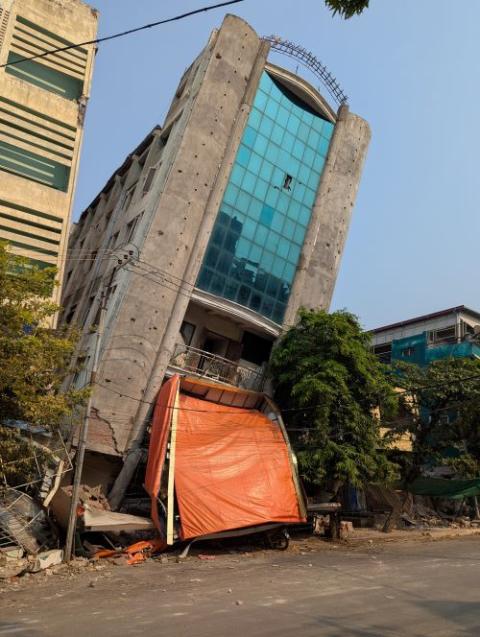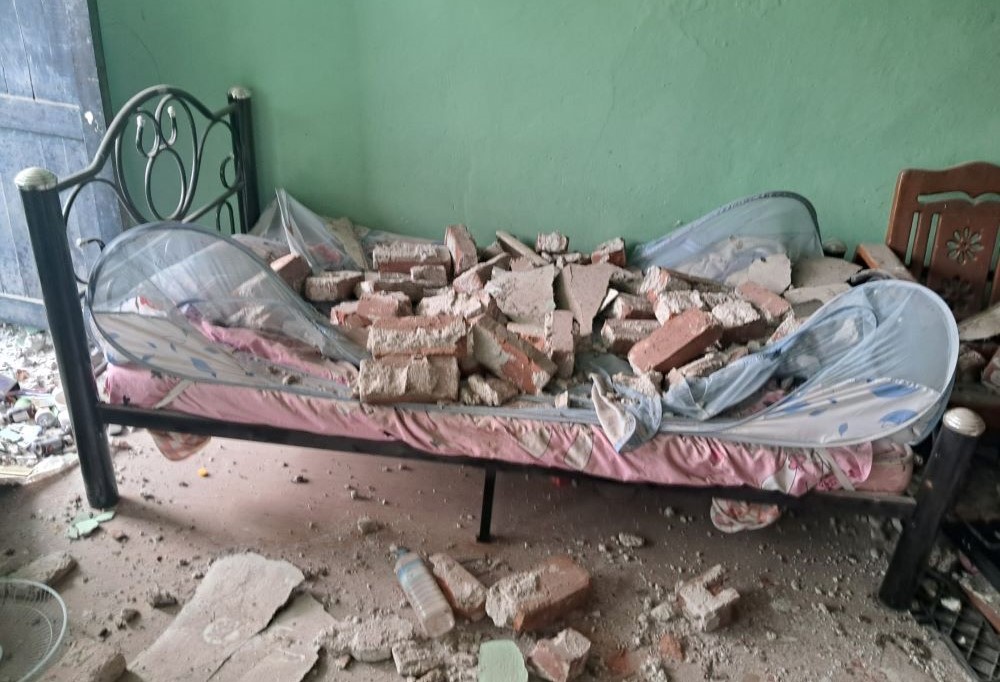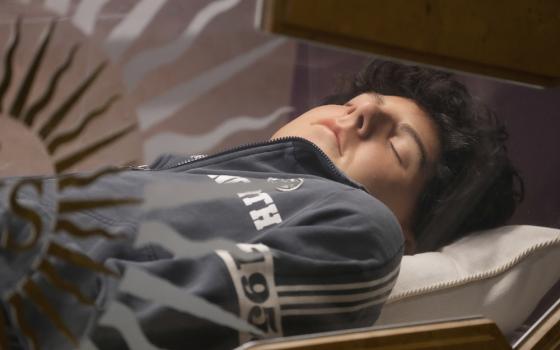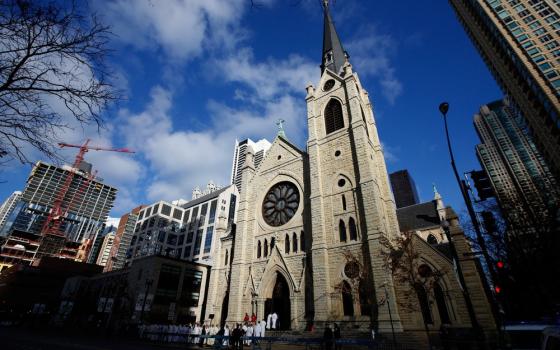People line up for food and relief supplies in Sagaing, Myanmar, April 2 in the aftermath of a 7.7- magnitude earthquake that hit midday March 28. Minutes after the quake subsided, Catholic Relief Services and other humanitarian organizations in the region, began working to supply essential supplies to those in need. (OSV News/Reuters)
Minutes after the strongest earthquake to strike Myanmar in more than a century subsided, Catholic Relief Services went to work.
Staff at its main Yangon office began contacting colleagues and church partners in the Mandalay-Sagaing region, the epicenter of the 7.7-magnitude earthquake that hit the war-torn Southeast Asian country on March 28. The earthquake leveled buildings and roads, knocked out power and communications and left at least 3,000 people dead — a number that could climb significantly.
CRS partners in the impact zone, including staff with the Caritas affiliate Karuna Mission Social Solidarity, shared stories of fleeing buildings and avoiding falling debris. Many took shelter in villages outside the city, then turned their attention from escaping disaster to responding to it.
"Everybody is still trying to grapple with [the earthquake], but the Myanmar people have resiliency in them. And it quickly pivoted to OK, what are we going to do about this now? And how can we start helping people?" said Cara Bragg, country manager for CRS Myanmar.

A magnitude-7.7 earthquake rattled buildings across Mandalay, Myanmar, on March 28, causing this one to lean to one side. (Courtesy of Catholic Relief Services)
By March 30, the first CRS team departed Yangon* and headed north with supplies to Mandalay, the country's second largest city. Damage to the main highway stretched a typically 10-hour drive into 16. A second team made the same trek on April 2, this time in 14 hours.
The greatest needs nearly a week after the earthquake remain food and clean water, along with items like clothes and bedding. Temporary shelter is a top priority, too; the quake damaged or destroyed many buildings and homes, and monsoon season nears.
"It's really strong and it's really long, the rain," Bragg said. "So getting people some form of shelter is going to be really critical, very quickly, especially before the monsoons."
The efforts by the Myanmar team come as Catholic Relief Services, the overseas development agency of the U.S. Catholic bishops, weathers its own internal crisis. Deep funding cuts by the Trump administration have severely threatened the agency's operations in many countries around the world.
"Our focus right now is really on the immediate assistance, the lifesaving assistance that has to go out within the first few weeks — within the first few days, really — of this type of event happening," Bragg said.
Bragg, an Ohio native, was working in the CRS Yangon office when she and other staff felt the ground shake about lunchtime on March 28. She had experienced other earthquakes since arriving in Myanmar in September 2023, but it was soon apparent this one was different.
The 7.7-magnitude earthquake was the strongest to hit the country since 1912, according to the U.S. Geological Survey. A 6.4-magnitude aftershock added to the devastation.
The impacts of the two quakes registered across Southeast Asia, with an under-construction skyscraper collapsing in neighboring Thailand and tremors felt in Bangladesh, India, Laos and China.
More than 3,000 people have been confirmed dead and 4,500 have been injured, according to the military junta governing Myanmar. The death toll could exceed 10,000 people, according to USGS modeling. The agency also estimated economic losses at $10-100 billion, which could surpass Myanmar's GDP. The United Nations estimated more than 17 million people have been impacted, with the hardest-hit areas still without water and electricity as of April 3.
A woman prays for her daughter and grandson in Bangkok, Thailand, April 1, following a 7.7- magnitude earthquake hit neighboring Myanmar midday March 28. At least 3,000 people died after the quake, and that number is expected to rise significantly. (OSV News/Reuters/Chalinee Thirasupa)
The military junta issued a state of emergency for the six impacted regions, and issued calls for international assistance. The United States, which has severely cut foreign assistance under President Donald Trump, has said it would send aid.
In a March 28 telegram, Pope Francis offered "heartfelt prayers" for the deceased as well as emergency workers dealing with the aftermath.
OSV News reported that several Catholic churches in Mandalay experienced damage. St. Joseph's Cathedral in Taunggyi, Shan State, also was damaged.
The earthquake's destruction only compounded a series of crises in Myanmar, where Catholics constitute roughly 1% of the predominantly Buddhist population. Since 2021, the country has been engulfed in civil war after a military coup overthrew the democratically elected government. An estimated 3.5 million people, a third of them children, have been displaced by the conflict.
Some of the most intense fighting has occurred where the earthquake struck. The military junta on April 2 declared a temporary ceasefire to last through April 22, the Associated Press reported. Before then, reports described bombings and airstrikes in the earthquake's aftermath by the junta.
Yangon Cardinal Charles Maung Bo, president of the Catholic bishops' conference of Myanmar, was among those who called for a pause in fighting, saying in a March 29 statement it was "imperative" to allow relief efforts to operate unimpeded.
"This humanitarian crisis calls for an urgent cessation of hostilities," Bo wrote.
The ongoing civil war is one of numerous factors complicating relief efforts.
Damage to roads and telecommunications have strained and slowed supply chains. Five hospitals in the impacted regions have been completely damaged and 61 facilities are partially damaged, according to the World Health Organization, and health centers still operating are overwhelmed and facing medical supply shortages. WHO estimates the earthquake will increase the risk of malaria, dengue, tuberculosis and cholera. Before the earthquake, WHO projected nearly 20 million people, or more than one-third of the population, needed humanitarian assistance.

The March 28 earthquake damages the home of a partner of CRS Myanmar. The magnitude-7.7 quake was the strongest to hit Myanmar in more than a century. (Courtesy of KMSS Mandalay)
While all the roughly 40 CRS staff and local partners in the Mandalay area survived the quake, many saw their homes damaged or completely destroyed.
Grappling with their own losses, the CRS team quickly shifted to providing assistance. They distributed supplies on hand from pre-existing projects, like tarpaulins, energy-fortified biscuits and cash, before reinforcements arrived from Yangon.
The extensive damage to roads and telecommunications has made getting aid to the impacted areas a challenge, Bragg said. Road repairs have begun, and CRS has coordinated with the United Nations and other relief organizations to devise ways to efficiently get aid to people.
"The response has already started, but it's at the early days," Bragg said.
The earthquake in Myanmar is one of the largest disasters to strike since Catholic Relief Services learned the Trump administration would significantly cut its U.S. government funding. .
CRS leadership projected that roughly half of the organization's total $1.5 billion budget projected for fiscal year 2025 would be lost due to the dismantling of the U.S. Agency for International Development, or USAID.
USAID has been a primary funder for CRS. In fiscal year 2023, it received nearly $521 million in public support, compared to $284 million from private sources. Upon retaking office in January, Trump immediately paused all U.S. foreign assistance for 90 days, and in the time since has worked to nearly dissolve USAID, shuttering its headquarters, whittling a staff of 10,000 people to 15 and terminating 83% of its programs.
Advertisement
Few details have emerged about the full extent of CRS funding cuts and the programs affected. In a March 17 statement, CRS said its funding losses "will permanently cut off critical aid to more than 20 million people worldwide," and endanger lives as well as efforts to alleviate poverty around the globe.
"We urge the administration to reverse these terminations and issue prompt payments to continue this life-saving and life-giving assistance," it said in the statement.
Before the earthquake, CRS Myanmar and its partners worked to assist more than 230,000 people. Programs addressed education and meeting basic needs, as well as agricultural projects to improve crop yields for small-scale farmers.
Now, they are focused fully on recovery.
Catholic Relief Services has set up a donation page on its website to support victims of the Myanmar earthquake. As time passes, the work will shift from providing life-saving resources to helping communities recover their lives and rebuild in ways to make them more resilient to future disasters, Bragg said.
"The massive destruction, especially when it comes to shelters and buildings, that's not something that can be fixed very quickly. So I can imagine it's going to be a long-term process for those things to recover," she said.
"It's definitely a really challenging situation right now, and a lot of support will be needed in the coming days to help people to navigate, to survive this, to start to recover."
*This story has been updated to correct the status of Yangon.







